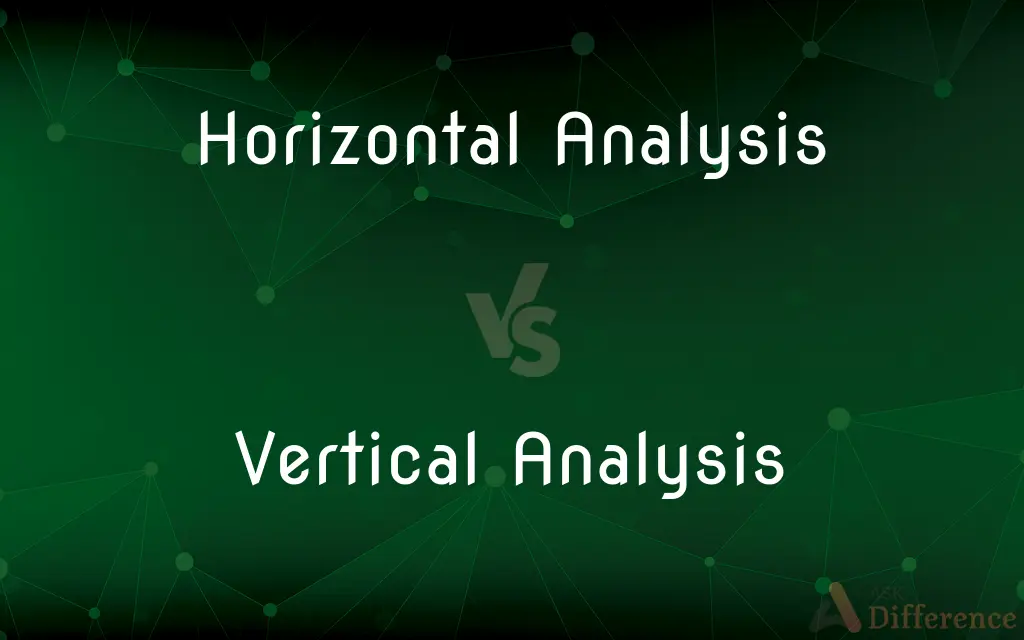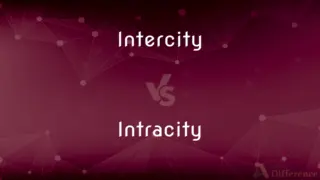Horizontal Analysis vs. Vertical Analysis — What's the Difference?
By Tayyaba Rehman — Published on October 17, 2023
Horizontal Analysis compares financial items over multiple periods, highlighting trends and growth rates. In contrast, Vertical Analysis evaluates each item in a single financial statement in proportion to a base item, providing a relative percentage.

Difference Between Horizontal Analysis and Vertical Analysis
Table of Contents
ADVERTISEMENT
Key Differences
Horizontal Analysis refers to the financial analytical method that assesses the relative changes in different items of the financial statement over the course of multiple periods, focusing on the development and trends. In contrast, Vertical Analysis is another method of financial statement analysis, where each item is represented as a percentage of a base item within the same period, which allows for understanding the composition and proportional relevance of each item in a financial statement.
Tayyaba Rehman
Oct 17, 2023
Horizontal Analysis is generally employed to assess the financial performance and health of a company over successive periods. This analysis helps in identifying the growth, stability, and sustainability of the company’s financial position over time. In contrast, Vertical Analysis is instrumental in understanding the distribution and allocation of resources within a specific period, offering insights into the structural composition of the financial statement.
Tayyaba Rehman
Oct 17, 2023
While performing Horizontal Analysis, analysts calculate the percentage change of each item compared to a base period, highlighting the variations and developments in the financial data. In contrast, when conducting Vertical Analysis, analysts express each item as a percentage of a base item, such as total revenue or total assets, in the respective financial statement, reflecting the relative proportion of each component.
Tayyaba Rehman
Oct 17, 2023
In conclusion, Horizontal Analysis and Vertical Analysis serve distinct purposes in financial analysis. Horizontal Analysis is oriented towards evaluating trends and developments over multiple periods, providing insights into the growth and sustainability of financial items. In comparison, Vertical Analysis focuses on understanding the proportional composition and relevance of financial items within a single period, offering a detailed perspective on the allocation and distribution of resources.
Tayyaba Rehman
Oct 17, 2023
In Horizontal Analysis, the emphasis is on observing the evolution and progression of individual financial items over time. This comparative method is particularly useful for identifying patterns, trends, and anomalies in the financial data. On the other hand, Vertical Analysis emphasizes the relationship and proportion of individual items within a single period, which is crucial for assessing the relative weight and significance of each component in the financial statement.
Tayyaba Rehman
Oct 17, 2023
ADVERTISEMENT
Comparison Chart
Purpose
To compare financial items over multiple periods and identify trends and growth rates.
To assess each item in a single period as a percentage of a base item.
Tayyaba Rehman
Oct 17, 2023
Focus
Trends and developments over time.
Proportional composition of each item in a single period.
Tayyaba Rehman
Oct 17, 2023
Comparison
Involves comparison of financial items across different periods.
Involves comparison of different items within the same financial statement.
Tayyaba Rehman
Oct 17, 2023
Calculation Method
Calculated as the percentage change in items compared to a base period.
Each item is represented as a percentage of a base item.
Tayyaba Rehman
Oct 17, 2023
Utility
Useful for assessing financial performance and sustainability over time.
Useful for understanding the relative significance and distribution of financial items.
Tayyaba Rehman
Oct 17, 2023
ADVERTISEMENT
Definitions
Horizontal Analysis
Horizontal Analysis is crucial for identifying patterns, anomalies, and developments in financial data.
Horizontal analysis detected irregularities in the expense accounts, leading to a more detailed audit.
Tayyaba Rehman
Sep 27, 2023
Vertical Analysis
Vertical Analysis focuses on the proportional composition of financial items within a single period.
Through vertical analysis, the disproportionate allocation of resources to various departments was identified.
Tayyaba Rehman
Sep 27, 2023
Horizontal Analysis
Horizontal Analysis involves calculating the percentage change of financial items compared to a base period.
Horizontal analysis of the balance sheet highlighted a significant increase in long-term liabilities over the quarters.
Tayyaba Rehman
Sep 27, 2023
Vertical Analysis
Vertical Analysis reflects the relationship and proportion of individual financial items within a specific period.
The vertical analysis of the cash flow statement revealed a significant percentage of cash inflow from financing activities.
Tayyaba Rehman
Sep 27, 2023
Horizontal Analysis
Horizontal Analysis provides insights into the evolution and progression of financial items across successive periods.
The insights gained from horizontal analysis helped in fine-tuning the company's financial strategies for the coming year.
Tayyaba Rehman
Sep 27, 2023
Vertical Analysis
Vertical Analysis offers insights into the relative weight and significance of each component in a financial statement.
Vertical analysis of the balance sheet provided a clearer picture of asset utilization within the company.
Tayyaba Rehman
Sep 27, 2023
Horizontal Analysis
Horizontal Analysis is the comparison of financial information over multiple periods to identify trends.
Through horizontal analysis, the company observed a consistent increase in revenue over the past five years.
Tayyaba Rehman
Sep 27, 2023
Vertical Analysis
Vertical Analysis is instrumental in understanding the structural composition and allocation of resources in financial statements.
Vertical analysis highlighted the high proportion of fixed costs in the company’s expense structure.
Tayyaba Rehman
Sep 27, 2023
Horizontal Analysis
Horizontal Analysis helps in assessing the growth and sustainability of a company’s financial position over time.
Horizontal analysis revealed the fluctuating profit margins, prompting a review of the company’s pricing strategy.
Tayyaba Rehman
Sep 27, 2023
Vertical Analysis
Vertical Analysis is the assessment of each item in a financial statement as a percentage of a base item.
Vertical analysis of the income statement showed that the cost of goods sold represented 60% of the total revenue.
Tayyaba Rehman
Sep 27, 2023
FAQs
Where is a Capital Receipt recorded in financial statements?
A Capital Receipt is typically recorded under balance sheet accounts.
Tayyaba Rehman
Oct 17, 2023
How does a Capital Receipt impact financial structure?
A Capital Receipt may alter the financial structure of an entity by creating liabilities or reducing assets.
Tayyaba Rehman
Oct 17, 2023
What is a Capital Receipt?
A Capital Receipt is funds received from non-operational, usually infrequent activities, altering the entity's financial structure.
Tayyaba Rehman
Oct 17, 2023
How does a Revenue Receipt impact an entity's operations?
A Revenue Receipt maintains the operational regularity, contributing to net income without creating liabilities or reducing assets.
Tayyaba Rehman
Oct 17, 2023
What is a Revenue Receipt?
A Revenue Receipt is funds received from regular, ongoing operational activities, maintaining the operational regularity of the business.
Tayyaba Rehman
Oct 17, 2023
Author Spotlight
Written by
Tayyaba RehmanTayyaba Rehman is a distinguished writer, currently serving as a primary contributor to askdifference.com. As a researcher in semantics and etymology, Tayyaba's passion for the complexity of languages and their distinctions has found a perfect home on the platform. Tayyaba delves into the intricacies of language, distinguishing between commonly confused words and phrases, thereby providing clarity for readers worldwide.

















































